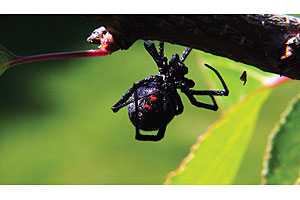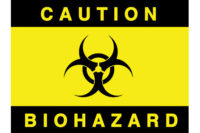
|
Venomous spiders and bees are among the pests that are of concern in a warehouse setting.
Even if they are not common to your area, spiders such as the black widow and the brown recluse can be found in shipped-in pipe or crates. Black-widow spiders are long-legged, shiny and coal-black in color with an orange, red or yellow hourglass shape on their underside. They usually are about 1 1/2-in. long. Brown recluses are about 1/2-in. long and have a dark violin-shaped mark on their combined head and midsection.
In most cases when a black widow bites a healthy adult, the reaction is mild with swelling and redness at the bite with one or two small fang marks that look like little red dots. To treat, apply ice and take over-the-counter pain medication. Symptoms of a severe reaction include muscle cramps and spasms, chills, nausea and vomiting. These symptoms require immediate emergency medical attention.
Symptoms of a brown recluse bite include reddened skin followed by a blister at the site of the bite, mild to intense pain and itching, and an open sore with a breakdown of tissue (necrosis) that develops roughly a week following the bite. Medical attention is recommended.
Wasps are another pest in a warehouse setting and are found in hives as well as in the ground or areas covered in grasses. Ground nests look like small granular mounds of piled-up dirt roughly 2 to 5 in. tall. Wasps will attack and sting if disturbed, so remain quiet and don’t move if one is around you.
If a wasp sting occurs, the stinger needs to be quickly removed to stop the injection of more venom. Scrape the area with a fingernail or credit card to remove the stinger. If stung on the hand, remove rings on the affected hand.
There are three types of reactions to wasp stings: normal, localized and allergic. A normal reaction will result in pain, swelling and redness around the sting site. A large local reaction will result in swelling that extends beyond the sting site. For example, a person stung on the ankle may have swelling of the entire leg. It is generally no more serious that a normal reaction.
An allergic reaction will result in difficulty breathing, hives that spread to areas beyond the sting, swelling of the face, throat or mouth tissue, wheezing or difficulty swallowing, restlessness, as well as anxiety, rapid pulse and dizziness. An allergic reaction is a medical emergency so call 911 for assistance.
Prevention is the most important aspect of an insect control program. Regularly have the warehouse sprayed for insects and inspected for evidence of pests. Make it mandatory for employees to wear gloves when handling product to avoid bites.
Do not allow food or drinks to be left in areas that can attract bees, and have employees avoid scented cosmetics and soaps. Most importantly, educate your employees on how to avoid stings and bites as well as what to do if they are stung or bitten. To assist with this effort, two Toolbox Talks have been developed and can be found at www.asa.net/safetyresources.
Author bio: Myles Dellger is a student at the University of Wisconsin-LaCrosse studying business management. This article and the accompanying online Toolbox Talks were produced as part of his internship program at LaCrosse-based First Supply. Eye on Safety is produced by the ASA Safety Committee. For more information, visit www.asa.net/safety-resources.




